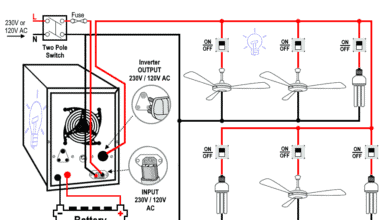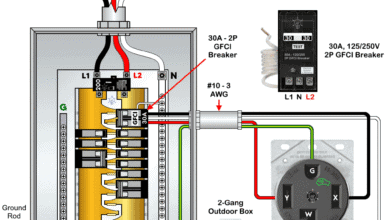How to Size a Branch Circuit Conductors with Protection?
Sizing of Branch Circuits and Conductors with Protection Supplying from OPCD to the Final Load Point
Branch Circuit
According to NEC 100 – Definitions, branch circuits are the circuit conductors between the final overcurrent device (OPCD) protecting the final load point.
In other words, the circuit conductors runs between the final circuit breaker to the final load circuit such as outlet(s) is known as a branch circuit.
Click image or open in a new tab to enlarge
Related Post: How to Size Service-Entrance Conductors and Feeder Cables?
Sizing Branch Circuit Conductors
To size a branch circuit, calculate the total amperage load of the connected appliances. Now, select a circuit breaker and wire size that can safely handle that load based on NEC Table 310.16. Make sure the ampacity of the conductors is at least equal to 125% of the continuous load and 100% of the non-continuous load, as per 210.19(A)(1). Finally, counter the voltage drop if distance between the OCPD and final circuit is more than 50 feet or 15.25 meters.
Sizing of the overcurrent devices (OCPDs) for branch circuit depends on branch-circuit load calculations (i.e. outlets and receptacles requirements). In addition, use the EGC sizing guide based on Table-250.122 to use the proper grounding equipment conductor with specified and rated branch circuit.
The National Electrical Code (NEC) 2023 provides clear guidelines for properly sizing branch circuits. The process involves determining the circuit load, selecting the appropriate conductor size, and choosing a suitable overcurrent protection device (OCPD).
Below is a step-by-step tutorial to properly size a branch circuit for lighting load, HVAC and motor circuits with solved examples according to NEC 2023.
Click image or open in a new tab to enlarge
Step 1: Determine the Load Requirements
Identify the type of load whether it is continuous or Non-Continuous. Sum the total amperage or wattage of all connected devices. Apply demand factors if necessary (NEC Article 220).
Continuous vs. Non-Continuous Load (NEC 210.19(A)(1))
- For continuous load which operates for <strong”>3 hours or more (e.g., water heater, HVAC), the branch circuit must be sized at 125% of the continuous load.
- For Non-Continuous load which operates for less than 3 hours, the branch circuit can be sized at 100% of the load.
For instance; if a circuit supplies a 32A continuous load:
32A × 1.25 = 40A
Thus, a minimum 40A conductor and breaker are required for the branch circuit.
Step 2: Select the Proper Conductor Size
Use NEC Table 310.16 to determine wire size based on ampacity. Consider ambient temperature correction and conduit fill adjustments (NEC 310.15) if applicable.
Common wire sizing (copper & aluminum conductors at 60°C terminals) and Maximum overcurrent protection. The rating of the overcurrent protection device (OCPD) determines the rating of a branch circuit in the following table based on NEC Table 310.16.
| Ampacity | Copper Wire Size | Aluminum Wire Size |
| 15A | #14 AWG | #12 AWG |
| 20A | #12 AWG | #10 AWG |
| 30A | #10 AWG | #8 AWG |
| 40A | #8 AWG | #6 AWG |
| 55A | #6 AWG | #4 AWG |
| 70A | #4 AWG | #2 AWG |
| 85A | #3 AWG | #1 AWG |
| 95A | #2 AWG | #1/0 AWG |
| 110A | #1 AWG | #2/0 AWG |
| 125A | #1/0 AWG | #3/0 AWG |
For instance, for a 40A branch circuit, use #8 AWG copper or #6 AWG aluminum or copper clade aluminum at 60°C.
Step 3: Select Overcurrent Protection
The rating of circuit breaker or fuse must match and but not less than conductor’s ampacity. Follow NEC 240.4(D) for small conductors: i.e.
- #14 AWG → 15A breaker
- #12 AWG → 20A breaker
- #10 AWG → 30A breaker
For instance, If using #8 AWG (40A ampacity), a 40A breaker or fuse is required.
Step 4: Consider Voltage Drop
Voltage drop should not exceed 3% for branch circuits (NEC 210.19(A)(1) Informational Note 2). For long runs, increase wire size to minimize voltage drop. If distance between the breaker and final circuit is more than 50 feet or 15.25 meters, add 20% additional ampacity for every 100 feet to counter voltage drop in long-distance runs.
For instance; in a 120V circuit, 100 ft, 20A load, #12 AWG copper, the voltage drop ≈ 4.2V (3.5%) which exceeds the recommended limit. Hence, the size of branch circuit wire will Increase to #10 AWG from #12 AWG.
Step 5: Apply NEC-Specific Rules for Different Loads & Branch Circuits
- Receptacles: NEC 210.21(B)(3) defines outlet ratings based on circuit ampacity.
- Motors: NEC 430.22 requires 125% of full-load current for motor branch circuits.
- HVAC: NEC 440.32 requires sizing at 125% of compressor current.
Related Post: How to Determine the Number of Branch Circuits? – 3 Ways
Example 1: Sizing Branch Circuit for 120V Lighting Load
A commercial office has a continuous lighting load of 7,500W at 120V. Determine the correct wire size and breaker size for branch circuit, if the panel is 100 feet away.
Solution:
1. Calculate the Load Current
I = P ÷ V
I = 7,500 W ÷ 120V
I = 62.5 A
Since this is a continuous load, apply the 125% rule (NEC 210.19(A)(1)):
Icont = 62.5A × 1.25 = 78.13A
2. Compensate the Voltage Drop
We have to counter the voltage drop when distance is involved. Since the distance between protective device and load point is more than 50 feet, we will have to add 20% additional ampacity for every 100 feet of length.
78.13A × 20% = 93.75A
Alternatively, calculating for voltage drop exceeds the allowable voltage drop of 3%, (NEC 210.19(A)(1) Informational Note 2).
Vd = (2 × k × I × L) ÷ CM
Where:
- k = resistivity constant for copper
- I = Current in Amps
- L = Length in ft
- CM = Circular mil area of AWG wire size
3. Select Wire Size
The suitable wire size for 100A branch circuit shall be chosen from NEC Table 310.16 (75°C rating):
#3 AWG copper = 100A → Suitable for 93.75A load.
4. Choose the Circuit Breaker
The rating of OCPD device can be selected as per NEC 240.6(A). The next standard breaker size above 93.75A is:
100A
So, a 100A breaker is selected for the branch circuit feeding a continuous lighting load of 7,500W at 120V.
5. Size the EGC for Branch Cricut
The size of equipment grounding conductor should be selected based on NEC table 250.122. From Table 250.122, the minimum size of EGC for 100A with #3 AWG branch circuit is:
- #8 AWG – Copper.
- #6 AWG – Aluminum or Copper-Clade Aluminum.
Hence, for a branch circuit of continuous lighting load (7,500W at 120V) at a distance of 100ft away, the suitable wire size is #3AWG copper, required breaker size is 100A, and EGC is #8 AWG Cu or #6AWG Al.
- Related Post: How to Determine the Number of Lighting Branch Circuits?
Example 2: Sizing Branch Circuit for 240V HVAC Load
A residential central air conditioning unit has the following electrical specifications:
- Compressor Full Load Amps (FLA): 32A
- Fan Motor FLA: 6A
- Minimum Circuit Ampacity (MCA): 40A
- Maximum Overcurrent Protection (MOCP): 60A
- Voltage: 240V, single-phase
- Wire run: 75 feet using copper conductors
Determine the wire size, breaker size, EGC size and voltage drop considerations according to NEC 2023.
Solution:
1 – Select Wire Size
Use MCA for Wire Sizing (NEC 440.32). MCA is given as 40A, so we select a conductor that meets or exceeds this value. From NEC Table 310.16 (75°C terminals): #8 AWG copper = 50A → Suitable for 40A MCA.
✅ Selected wire size: #8 AWG Copper
2 – Select Breaker Size
Use MOCP for Breaker Sizing (NEC 440.22(A)). MOCP is given as 60A, meaning we can use a 60A breaker as per NEC.
✅ Selected breaker: 60A
3 – Check Voltage Drop
Vd = (2 × k × I × L) ÷ CM
Where:
- k = 12.9k = resistivity constant for copper
- I = 40A
- L = 75ft
- CM = for #8 AWG = 16510
Putting the values:
Vd = (2 × 12.9 × 40 × 75) ÷ 16510
Vd = 4.68V
Voltage drop percentage:
(4.68V ÷ 240V) × 100 =1.95%
✅ Since 1.95% < 3%, the voltage drop is acceptable.
4 – Select EGC Conductor
The size of equipment grounding conductor are selected based on NEC table 250.122. Hence, the minimum size of EGC for the branch circuit with #8 AWG conductors are
- ✅ #10 AWG – Copper.
- ✅ #8 AWG – Aluminum or Copper-Clade Aluminum.
This way, for a branch circuit feeding an HVAC circuit at 40 MCA and 60 MOCP at a distance of 75ft away, the suitable wire size is #8 AWG copper, required breaker size is 60A, and EGC is #10 AWG Cu or #8AWG Al.
Example 3: Sizing Branch Circuit for 460V, 3-Phase Motor
A 3-phase, 460V, 25HP motor is installed in an industrial facility. Determine the proper wire size, breaker size, and overload protection according to NEC 2023. Assume a 100-foot run and copper conductors.
Solution:
1: Determine Full-Load Current (FLC)
From NEC Table 430.250, the FLC for a 25HP, 460V, 3-phase motor is:
IFLC = 34A
Since motors are considered continuous loads, apply the 125% rule (NEC 430.22):
Icont = 34A × 1.25 = 42.5A
2: Select Wire Size
From NEC Table 310.16 (75°C column):
- #8 AWG copper = 50A → Suitable for 42.5A
3: Select Circuit Breaker
As per NEC NEC 430.52(C)(1), the maximum breaker size for an inverse time circuit breaker is:
250% × IFLC
250% × 34A = 85A
From NEC 240.6(A), the next standard breaker size is: 90A
So, a 90A breaker is selected.
4: Select Overload Protection
The overload relay is sized at 115% of FLC for motors without a service factor of 1.15 or higher:
Overload Protection = 34A × 1.15 = 39.1A
A 39A or 40A overload protection device is required.
5: Check Voltage Drop
Using the voltage drop formula (see details in second example)
Vd = (2 × k × I × L) ÷ CM
Calculating for voltage drop which is 6.64V and the voltage drop percentage:
(6.64V ÷ 460V) ×100 =1.44%
Since the voltage drop is below 3%, the selected #8 AWG coper wire is acceptable for this branch circuit.
6: Select EGC Wire Size
The selection of equipment grounding conductor (EGC) depends on the rating of the overcurrent protection device (OCPD) given in NEC table 250.122. From Table 250.122, the minimum size of EGC for 90A with #8 AWG copper branch circuit for 3-phase motor is:
- #8 AWG – Copper.
- #6 AWG – Aluminum or Copper-Clade Aluminum.
Based on the above calculations, the branch circuit parameters for a 3-phase, 460V, 25HP motor is:
- ✅ Wire Size: #8 AWG Copper
- ✅ Breaker Size: 90A
- ✅ Overload Protection: 39A or 40A
- ✅ Voltage Drop: 1.44% (Acceptable)
- ✅ Selected EGC: #8 AWG Copper (or #6 AWG Aluminum)
Resources:
- How to Size Equipment Grounding Conductor (EGC)?
- How to Size Grounding Electrode Conductor (GEC)?
- How to Find the Proper Size of Wire & Cable in Metric & Imperial Systems
- How to Find the Proper Size of Circuit Breaker?
- How to Size a Load Center, Panelboards and Distribution Board?
- How to Determine the Right Size Capacity of a Subpanel?
- What is the Correct Wire Size for 100A Breaker and Load?
- What is the Right Wire Size for a 4.8kW, 240V Range: #10 or #12?
- How to Determine the Number of Circuit Breakers in a Panel Board?
- How to Find Power, Voltage & Ampere Rating of Outlet, Receptacle and Plugs
- How to Size the Earth Conductor, Earthing Lead & Earth Electrodes?
- How to Size a Generator? Portable, Backup & Standby for Home & Commercial Applications
- How to Size and Find the Numbers of Ceiling Fan in a Room?
- How to Calculate the Number of Fluorescent Lamps in a Final Sub Circuit?
- How to Calculate the Number of Incandescent Lamps in a Final Sub Circuit?
- How to Size a Single Phase and Three Phase Transformer in kVA?
- How to Calculate the Battery Charging Time & Battery Charging Current ?
- How To Calculate Your Electricity Bill?
- How to Calculate the Floor Area For General Lighting?
- How to Find the Number of Lights on a Single Circuit Breaker?
- How to Find the Number of Outlets on a Single Circuit Breaker?
- How to Determine the Suitable Size of Inverter for Home Appliances?
- How to Calculate the Right Size of Solar Charge Controller?
- How to Calculate the Right Size Battery?
- How to Size Panels, Batteries, Charge Controller and Inverter for Home
- How to Calculate the Number of Panels for a Load without Battery Backup?
- How to calculate the Cable size for LT & HT Motors?
- What is the Right Wire Size for 15A Breaker and Outlet?
- What is the Suitable Wire Size for 20A Breaker and Outlet?








